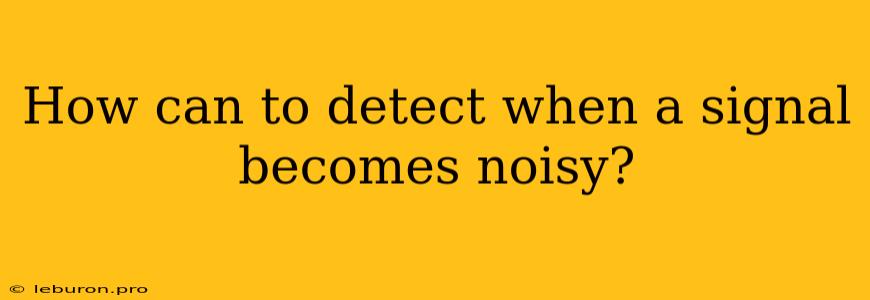In the realm of signal processing, it's crucial to discern between meaningful data and unwanted noise. Noise can corrupt a signal, hindering accurate analysis and interpretation. This article will delve into the complexities of detecting when a signal becomes noisy and explore various techniques that can aid in this crucial task. We'll examine the characteristics of noise, discuss commonly used methods, and provide examples to illustrate their application. By understanding how to identify noisy signals, engineers and scientists can make informed decisions about data quality and implement appropriate noise reduction techniques.
Understanding Noise
Noise is an unwanted disturbance that contaminates a signal. It can arise from various sources, including:
- Thermal Noise: Generated by the random motion of electrons in electronic components.
- Shot Noise: Arises from the discrete nature of electrical charge carriers.
- Flicker Noise: A low-frequency noise often associated with electronic devices.
- Interference: External signals that intrude on the desired signal.
Recognizing when a signal becomes noisy is essential for maintaining data integrity. Noise can manifest in different ways, including:
- Increased Variability: The signal exhibits greater fluctuations and deviations from its expected pattern.
- Distortion: The original waveform is altered, making it difficult to recognize.
- Loss of Information: Noise can obscure meaningful features and patterns in the signal.
Techniques for Detecting Noisy Signals
Several methods can be employed to detect noisy signals:
1. Statistical Analysis
- Mean and Standard Deviation: Calculating the mean and standard deviation of the signal can provide insights into its overall variability. A significant increase in standard deviation may indicate the presence of noise.
- Signal-to-Noise Ratio (SNR): This metric quantifies the ratio of the signal's power to the noise power. A low SNR suggests a noisy signal.
- Autocorrelation: Analyzing the correlation of a signal with itself can reveal patterns and periodicities. Noise tends to disrupt these patterns, leading to a decrease in autocorrelation.
2. Spectral Analysis
- Frequency Domain Analysis: Transforming the signal into the frequency domain using techniques like the Fast Fourier Transform (FFT) can help identify frequencies dominated by noise.
- Power Spectral Density (PSD): Plotting the PSD reveals the distribution of signal power across different frequencies. Peaks in the PSD at specific frequencies may indicate the presence of narrowband noise.
- Spectral Entropy: Measuring the entropy of the signal spectrum can indicate the complexity of the signal. A higher entropy suggests a greater degree of randomness, which could be due to noise.
3. Wavelet Analysis
- Time-Frequency Localization: Wavelets provide a powerful tool for analyzing signals in both the time and frequency domains. This allows for the identification of noise components that may be localized in time or frequency.
- Wavelet Coefficients: By analyzing the wavelet coefficients, one can identify regions where the signal is dominated by noise.
- Wavelet Thresholding: A common technique for noise reduction involves setting a threshold on the wavelet coefficients and removing coefficients below this threshold.
4. Thresholding
- Fixed Thresholding: Setting a fixed threshold value based on prior knowledge of the signal and noise levels.
- Adaptive Thresholding: Adapting the threshold based on local signal characteristics, such as mean or standard deviation.
- Otsu's Method: An algorithm that automatically determines the optimal threshold by maximizing the between-class variance.
5. Filtering
- Low-Pass Filtering: Attenuates high-frequency components, often effective in removing high-frequency noise.
- High-Pass Filtering: Removes low-frequency components, useful for isolating high-frequency signals from low-frequency noise.
- Band-Pass Filtering: Isolates a specific frequency band, allowing the removal of noise outside this band.
- Median Filtering: A non-linear filter that replaces each data point with the median of its neighboring values, effective in removing impulsive noise.
Examples
Example 1: Audio Signal
Consider an audio recording of a speech signal contaminated with background noise. By analyzing the power spectral density of the audio signal, we can identify frequency bands where noise dominates. Using a band-stop filter to remove these frequencies can significantly improve the quality of the speech signal.
Example 2: Image Processing
Imagine a digital image corrupted by salt-and-pepper noise. Applying a median filter can effectively remove these noise artifacts while preserving the edges and details of the image.
Conclusion
Detecting noisy signals is a critical task in various fields, including signal processing, image analysis, and data science. The techniques discussed in this article provide a comprehensive toolkit for identifying and mitigating noise contamination. By understanding the characteristics of noise and applying appropriate methods, engineers and scientists can ensure the quality and integrity of their data, leading to more accurate and reliable results.
